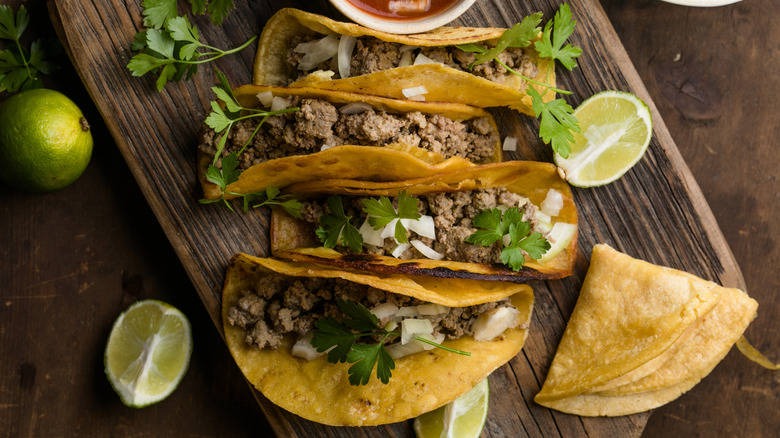Why Limes Are So Important When Making Tacos
We may receive a commission on purchases made from links.
Whether you prefer queso or shredded cheese, lettuce or cilantro, ground beef or tongue, there's one thing that your taco always needs: a squeeze of lime. Jenny Martinez, cookbook author and social media personality, said that it's just as vital as meat or tortilla and critical to enhancing all the flavors.
"The acidity helps to make the other flavors in the taco stand out," explained Martinez. "A taco is usually never complete without onion, cilantro[,] and lime!" Whether you're chowing down on some rich, luscious al pastor or the leanest marinated chicken breast, that extra touch of acidity brightens up every flavor and pairs perfectly with ground chiles and onions. It's one of the reasons restaurant tacos taste so much better than homemade ones — because that spark of sour and splash of moisture melds everything together. Plus, their intense flavor means you don't have to risk overloading your tacos with too many condiments, a common topping mistake for fish tacos and other delicate meats.
That moisture is especially important when you eat small, soft tacos. The onions and cilantro have a tendency to fall out, but by giving them a quick spritz of lime, it dampens them all together into a more coherent mass that stays in the tortilla far better.
Common lime mistakes for tacos
While limes are delicious, you don't necessarily want them to be the primary flavor in a taco. Most restaurants serve thin slivers for each one to guarantee you don't accidentally use too much juice, but if you're making them at home, you'll want to avoid adding them too early or using the wrong type.
"Lime is just used as a topping right before eating," Jenny Martinez insisted. While it may be tempting to prep a whole plate of tacos at once, always steer clear of prematurely adding the lime. Not only do you run the risk of soaking your tortillas, but you could also make delicate toppings, like cilantro, and even crispy meat, like carnitas, grow soggy. Waiting until right when you eat also has the added benefit of giving your meat a little bit of extra moisture, guaranteeing it tastes juicy even if dried out a bit.
You'll also want to make sure you use the right type of lime. Persian limes, the oblong type most common in America, are a solid go-to, but small, round Key limes are more common in Mexico and have a bit of a floral bouquet. Sweet varieties don't mesh with other taco flavors as well, and Thai kaffir limes tend to have a soapy flavor. Always pick something that's a touch soft when you squeeze it and feels heavy for its size, as these are solid indicators that it has more juice.


